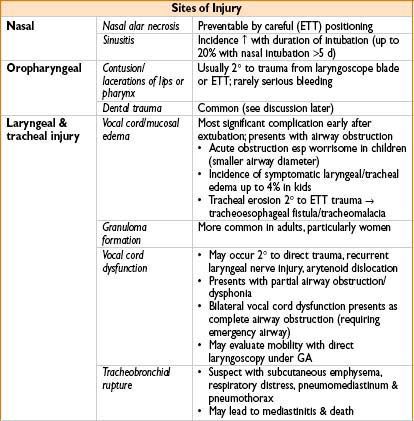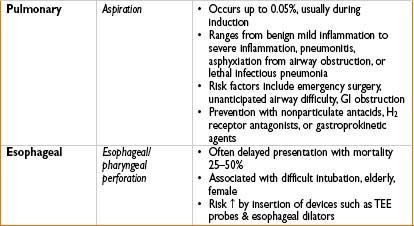
AIRWAY/DENTAL COMPLICATIONS
Airway Complications
Incidence
• Unknown owing to varying significance/detection of injuries
• Minor trauma to larynx & pharynx may be as common as 6%
• Damage typically ↑ in relation to duration of intubation (many injuries result from placement of endotracheal tube)
• Many injuries occur during routine, “easy” intubations
• Delayed, chronic complications often present weeks to even months after extubation, particularly with prolonged intubations (>5 d)
Risk Factors for Intubation Trauma
• Difficult, traumatic, multiple attempts at intubation
• Laryngeal abnormalities (past trauma, inflammatory conditions, infection)
• Movement of endotracheal tube (tube manipulation/surgical repositioning, coughing/bucking)
• Impaired clearance of secretions
• Gastroesophageal reflux


Prevention
• Use small ETTs with lowest possible cuff pressures (leak <30 cm in pediatric pts)
• Limit use of adjuncts (such as intubating stylets)
• Wean ventilator to minimize duration of intubation
• Treat airway infections aggressively & early
• Minimize aspiration risk (when risk factors present)
• Perform detailed assessment to prevent unanticipated airway difficulty (to ↓ chance of otherwise preventable airway injury)
• Prepare alternative plans if intubation fails
• Discuss risk of airway injury with pts preop (shown to ↓ litigation)
Management
• Acute airway edema/stridor: Nebulized racemic epinephrine; dexamethasone controversial
• Prolonged intubation (>5 d): Consider laryngeal evaluation to evaluate for injury
• Chronic injury from repeated/prolonged intubation: Surgical correction may be required
• Tracheobronchial rupture: Emergent surgical correction
Obtain follow-up if concerned about airway trauma
• Inform pts if airway management was difficult/nonstandard
Dental Injuries
• Dental trauma: Most common permanent airway injury & leading source of malpractice claims (30–40%)
• Injuries: Fractured teeth, displaced restorations, subluxation, & avulsion (upper incisors most commonly affected secondary to use as fulcrum for laryngoscope)
Deciduous tooth loss → can result in problems with permanent teeth
• Adverse outcomes → related to aspiration of teeth/restorations
Incidence
• Overall incidence: Reports range from 0.02–12% (75% of injuries occur during intubation)
• Injuries can occur during maintenance (poorly positioned airway, bite block, masseter spasm during wakeup)
Risk Factors
• Tracheal intubation; poor dentition/periodontal disease; difficult airway characteristics; past dental restoration/endodontic treatment; elderly pts; brittle enamel; loose deciduous teeth; inexperienced laryngoscopist
Prevention
• Detailed preop history & examination:
→ Caries/loose teeth, prostheses, past dental work
→ Assess mouth opening
→ Evaluate dentition, evidence of periodontal disease, tooth hypermobility
→ Document preexisting conditions (reduces litigation if damage occurs)
• Consider tooth protection
→ Protectors (prefabricated rubber/custom-made by dentist)
Management
• Loosened tooth
Return to original position promptly; splint with tape/suture
• Displaced fragment of tooth/restoration:
Locate & recover all pieces; consider radiographs (chest, lateral head & neck) to exclude passage through glottis
• Avulsed tooth
Immediately replace tooth to original position
Avoid wiping or drying root surface
Splint temporarily with tape/suture
If aspiration concern prevents immediate reimplantation
→ carefully place tooth in suitable medium (saline/milk)
Immediate dental referral, injury documentation & discussion with pt important
• Most hospitals require filing an incident report
• Reimbursement responsibility depends on hospital policy
Burns
Intraoperative burns are rare; can be devastating/fatal
Surgical Fire
• 200 surgical fires per year in the United States
• Fire requires O2, flammable materials, & ignition source
→ O2 commonly administered in OR (endotracheal, nasal cannula)
→ Flammable materials = surgical drapes, alcohol prep solutions, plastic ETTs
→ Ignition sources = laser, electrosurgical units (ESUs), cautery
• Head & neck surgeries represent most cases involving fire in OR
→ Higher risk since nasal cannulas + laser/electrocautery → combustion
→ ETT carrying enriched O2 can also ignite, leading to a “blowtorch” effect during positive-pressure ventilation
Airway Fire
• Prevention: Decrease FiO2 during lasering; Use heliox; Use fire resistant ETTs; Wrap ETT in metal tape; Fill ETT cuff with saline, not air
• Management: Remove ETT/stop ventilation, discontinue O2, douse fire with saline/water, mask-ventilate pt; Perform bronchoscopy to assess airway damage
Electrocautery/Electrosurgical Unit
• Current path: Electrosurgical pencil → through pt → out grounding pad
• Current density dissipated over large surface area → limits risk of burn (because of low impedance return electrode)
• ESU-associated burns:
→ Improper placement of return electrode (↓ contact surface area)
→ Fluids (blood, irrigation, skin prep) cause improper electrode contact
→ Avoid placement of return electrode over bony prominences
→ ESUs can serve as ignition source (esp if ↑ O2 conc in use)
Magnetic Resonance Imaging
• Complications usually involve metallic objects flying into magnetic field & burns
• MRI radio frequency can cause heating of current conducting materials:
→ ECG cables & electrodes
Remove excess cables & avoid cable contact with skin
Do not loop cables, ensure that ECG electrodes are firmly attached
→ Medicated patches
Some contain aluminized backing (can heat in MRI)
Avoid testosterone, nitro, nicotine, scopolamine, clonidine patches
Perioperative Blindness

Stay updated, free articles. Join our Telegram channel

Full access? Get Clinical Tree








